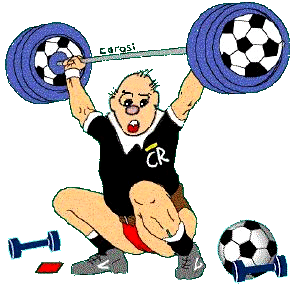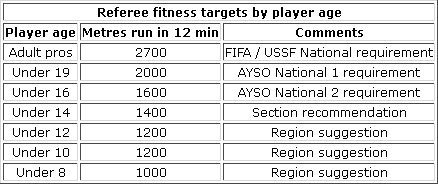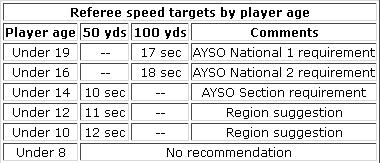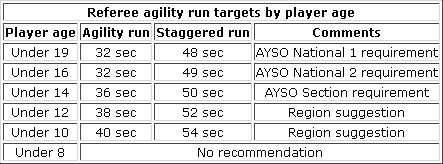| |
 |
HOW FIT DO YOU NEED TO BE?
Preparing and Training…
Andrew Castiglione
Founder of Ken Aston Referee Society
 |
There are three kinds of fitness that are of concern to a Soccer Referee
- endurance, speed and agility. Endurance allows you to keep going
throughout the game; speed allows you to cover ground when the play
moves away from you sharply; and agility allows you to change direction
quickly.
FIFA Fitness Test
 This Video from the... Ken Aston Referee Society -
This Video from the... Ken Aston Referee Society -
 Channel Channel

Here we give some suggestions for measures and targets for each of these
for Referees in the various player age groups of AYSO, USSF, etc... If
you test yourself against these, please take it easy and don't hurt
yourself. Especially if you have not been running regularly recently, do
the drills gently at first and slowly increase the effort level. If you
decide you want to improve your results, start a regular exercise
routine (e.g. as described in Get fit!) and just occasionally measure
yourself again (rather than running the drills over and over). A more
balanced workout regime is safer, more fun and will still produce a
rapid improvement when you measure yourself again.
Endurance
Although "When you're fit.." gives estimates of total distance covered
in a game for games of different age levels, most soccer organizations
measure a referee's fitness by the distance the referee can run in 12
minutes. Here are the recommended targets for folks ranging from FIFA
international referees on down.

The target distances are given in meters: 1 mile is 1600m; 400m is one lap of any normal running track.
The targets for Under 14 on down are very undemanding. Younger Referees,
or those who aspire to very tight coverage of play, should shoot for
2000m or better. If we consider targets for Referees of different ages,
David Ager, in
'The Soccer Referee's' manual, gives the following guidelines for
an "in condition" referee for the 12 minute run.

Speed
Being able to jog 2000m in 12 minutes is a good foundation, and you will
spend a lot of time following play at this relaxed pace. However, as we
all know, Referees also have to be able to sprint to catch up with
breakaways, or when the play suddenly moves in an unexpected direction.
Here are some recommended targets for AYSO, USSF referees.

Agility
Agility is important for when you have to stop or change
direction quickly, and for running side wards and backwards. This is
probably even more important for assistant referees (lines folk), since
side stepping and sudden starts and stops are so frequent on the line.
There are two drills used to test agility.
 - 1.
Agility run: A square 10m on a side is laid out. The referee begins at
one corner and runs backwards along one side, side steps right along the
next, runs forward along the third and side steps right along the fourth
(arriving back at the start point). The referee then returns around the
square, side stepping left, backwards, left and forwards in turn. The
time is the total time around the square twice.
- 1.
Agility run: A square 10m on a side is laid out. The referee begins at
one corner and runs backwards along one side, side steps right along the
next, runs forward along the third and side steps right along the fourth
(arriving back at the start point). The referee then returns around the
square, side stepping left, backwards, left and forwards in turn. The
time is the total time around the square twice.
 - 2.
Staggered run: Marks are placed in a straight line at 5, 10, 15, 20 and
25 metres from a start point. The referee runs from the start point to
the 5m mark, back to the start, to the 10m mark, back, etc. until each
mark has been visited and returned from (a total of 150m).
- 2.
Staggered run: Marks are placed in a straight line at 5, 10, 15, 20 and
25 metres from a start point. The referee runs from the start point to
the 5m mark, back to the start, to the 10m mark, back, etc. until each
mark has been visited and returned from (a total of 150m).
Here are some recommended targets for those drills for AYSO, USSF referees.

 - Be careful running these drills! These are exactly the kind of
movements that will strain or pull muscles if you overdo it before you
are used to them. Take them slowly until they feel comfortable.
- Be careful running these drills! These are exactly the kind of
movements that will strain or pull muscles if you overdo it before you
are used to them. Take them slowly until they feel comfortable.
|